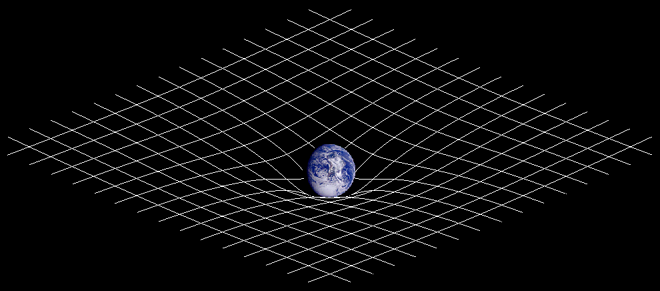Of course not. No sane person denies the facts of gravity. But that doesn’t mean that there hasn’t been debate about HOW gravity works. The first great description of gravity came from Isaac Newton who described how objects attract each other and was the first to describe the mathematics of it. His “Inverse Square Law” described how gravity’s strength diminishes in proportion to the square of the distance between two objects. Double your distance from a large object and the gravitation attraction will only be one quarter of what it was. At ten times the distance the gravity will be a mere hundredth of what it was. All of this is true, certainly true enough for everyday purposes. True enough for getting spacecraft to the moon and back. True enough for almost all circumstances.
It explains things like the tides. Few people who’ve travelled to the coast have thought much about tides, why the sea level rises and falls twice a day and I suspect most people find it surprising that the water is being pulled away from the center of the Earth by the gravitational attraction of the moon. They would find it even more perplexing that the tide rises on both the side closest to the Moon AND the side furthest away. How can that be? (The first person to email me the correct explanation will get a prize.)
The problem is that although Newton described the mathematics of gravity he didn’t explain how it actually happened. He referred to objects attracting each other but didn’t say how they do this. How can a star like our Sun exert an instantaneous force on a planet like Earth from such an enormous distance? Newton didn’t know.
 |
| C/o Wikipedia http://en.wikipedia.org/wiki/General_theory_of_relativity |
Here’s the key point. Einstein’s “Theory” of General Relativity is a theory. It’s a way of explaining thing, including gravity. There is no “theory of gravity” because there’s no need. Gravity is like radiation, reproduction and rain, we don’t need proof that these things exist, the evidence is overwhelming. Theories are ways of explaining WHY and HOW known things happen, not that they DO happen.
The controversy isn’t with gravity, it’s with the other great known fact. Evolution.
Evolution happens, it’s as simple as that. It’s been observed in a wide variety of creatures, their characteristics adapting gradually as a result of changes in their environment. That isn’t denied by anyone who’s seen the evidence. Fossils show that creatures in the past were different to similar creatures today and the further back you go in the fossil record, the bigger the differences are.
There is no “theory of evolution” just like there’s no “theory of gravity”. There ARE however theories of HOW and WHY evolution happens and what makes species gradually change. So far, just as Einstein’s Theory of General Relativity explains gravity well, the best explanation we have for evolution is Darwin’s Theory of Natural Selection. Despite what you might think, and unlike Einstein’s theory, Darwin’s suggestion is remarkably simple to understand. It has only two basic ideas. When species reproduce they combine their genes randomly and this occasionally leads to offspring with particular strengths or weaknesses. The second element is just as simple to understand. Those random variations that give the offspring a better chance of reproducing and passing on his or her genes to the next generation are most likely to stick around. That’s all there is to it. Over time and thousands of generations these slight changes bring about a much bigger overall change to the species as a whole.
So far, just like Einstein’s theory, Darwin’s has shown considerable strength. Both make predictions that can be tested and so far no test of either theory has failed. Of course it might fail tomorrow and then we’ll need to come up with a new, better theory but so far there’s no need.
For now, despite what certain belief-based groups will tell you, we can stick with both General Relativity and Natural Selection as the best theories we have to explain the FACTS of gravity and evolution.
No comments:
Post a Comment